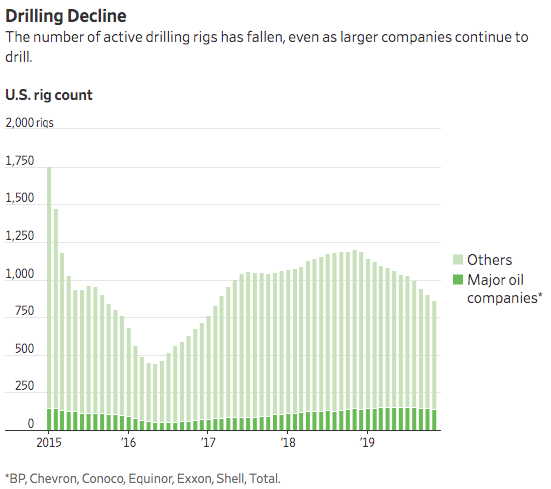Gateway to Think Tanks
| 来源类型 | Commentary |
| 规范类型 | 评论 |
| Oil Rig Count Down; Oil Production Up | |
| IER | |
| 发表日期 | 2019-11-27 |
| 出版年 | 2019 |
| 语种 | 英语 |
| 正文 | According to the Energy Information Administration (EIA), U.S. oil production for the first nine months of 2019 averaged over 12 million barrels per day. That level of production is 1.4 million barrels per day higher than the same period last year, despite the oil rig count declining steadily in 2019. EIA sees increasing oil production as the trend for the near future. In EIA’s Short Term Energy Outlook, oil production is expected to end the 2019 year 1.3 million barrels per day higher than last year, and it is expected to be another 1 million barrels a day higher next year ending the 2020 year with oil production at 13.29 million barrels per day. Despite the increase in oil production, the oil rig count declined over a record 11 months as independent exploration and production companies cut spending on new drilling, focusing on earnings growth instead of increased output. U.S. financial services firm Cowen & Co indicated that projections from the exploration and production companies it tracks point to a 5 percent decline in capital expenditures for drilling and completions in 2019 versus 2018. The exploration and production companies Cowen tracks reported plans to spend about $80.5 billion in 2019 versus $84.6 billion in 2018. But that decline, both in magnitude and direction, differs by major oil and gas producers versus independent producers. According to Cowen, independent producers expect to spend about 11 percent less in 2019, while major oil companies plan to spend about 16 percent more.  Shale Producers Many independent oil shale companies are expected to lower investment spending that would likely slow growth in future oil production. The companies hope that slower growth may result in higher commodity prices. These small and midsize shale producers are emphasizing profitability, making it more challenging for the companies to drill new wells as rapidly as they did previously. A pullback by these oil producers would likely cause U.S. oil production growth that slowed a bit this year to slow further in 2020. The slower rate of new wells means companies will need to obtain greater production out of each well to sustain current production levels. Some data indicates that the production gains from technological advances are leveling off. Gains in oil production from U.S. onshore drilling rigs are declining. In December, drilling rigs helped extract 25 percent more oil than they had a year ago. In August, they were producing about 14 percent more than last year. Further, oil production in the first 90 days of an average shale well—the time when it is most productive—declined by 10 percent in the first half of the year compared to the 2018 average. Data show that across North Dakota’s Bakken Shale region, well productivity has not improved since late 2017. In other mature shale regions, such as the Eagle Ford in South Texas, many operators have experienced productivity per horizontal foot decline as they have supersized their wells—drilling bigger and often more expensive wells to recover a similar amount of oil. However, as the exploration and production data above noted, major oil companies such as Exxon Mobil and Chevron that are increasing their shale footprint, particularly in the Permian Basin of Texas and New Mexico, are investing heavily in factory-style shale production. It is unclear how much the increased investment and production from the major producers would outweigh the slower growth in production from the independent producers. Conclusion Oil drilling rig counts are down, but U.S. oil production is still increasing, just at a slightly slower rate. According to EIA, the trend in oil production growth is expected to continue with oil production next year reaching 13.29 million barrels per day—1 million barrels a day above what is expected for this year’s oil production. Many independents are investing less, focusing on profitability, but major oil companies are expected to continue to invest and increase production. |
| 标签 | Bakken Shale Formation ; crude oil production ; Domestic Oil Production ; drilling ; energy production ; oil production ; Oil Rigs ; shale boom ; shale oil ; U.S. Oil Production |
| URL | https://www.instituteforenergyresearch.org/fossil-fuels/gas-and-oil/oil-rig-count-down-oil-production-up/ |
| 来源智库 | Institute for Energy Research (United States) |
| 资源类型 | 智库出版物 |
| 条目标识符 | http://119.78.100.153/handle/2XGU8XDN/413777 |
| 推荐引用方式 GB/T 7714 | IER. Oil Rig Count Down; Oil Production Up. 2019. |
| 条目包含的文件 | 条目无相关文件。 | |||||
| 个性服务 |
| 推荐该条目 |
| 保存到收藏夹 |
| 导出为Endnote文件 |
| 谷歌学术 |
| 谷歌学术中相似的文章 |
| [IER]的文章 |
| 百度学术 |
| 百度学术中相似的文章 |
| [IER]的文章 |
| 必应学术 |
| 必应学术中相似的文章 |
| [IER]的文章 |
| 相关权益政策 |
| 暂无数据 |
| 收藏/分享 |
除非特别说明,本系统中所有内容都受版权保护,并保留所有权利。